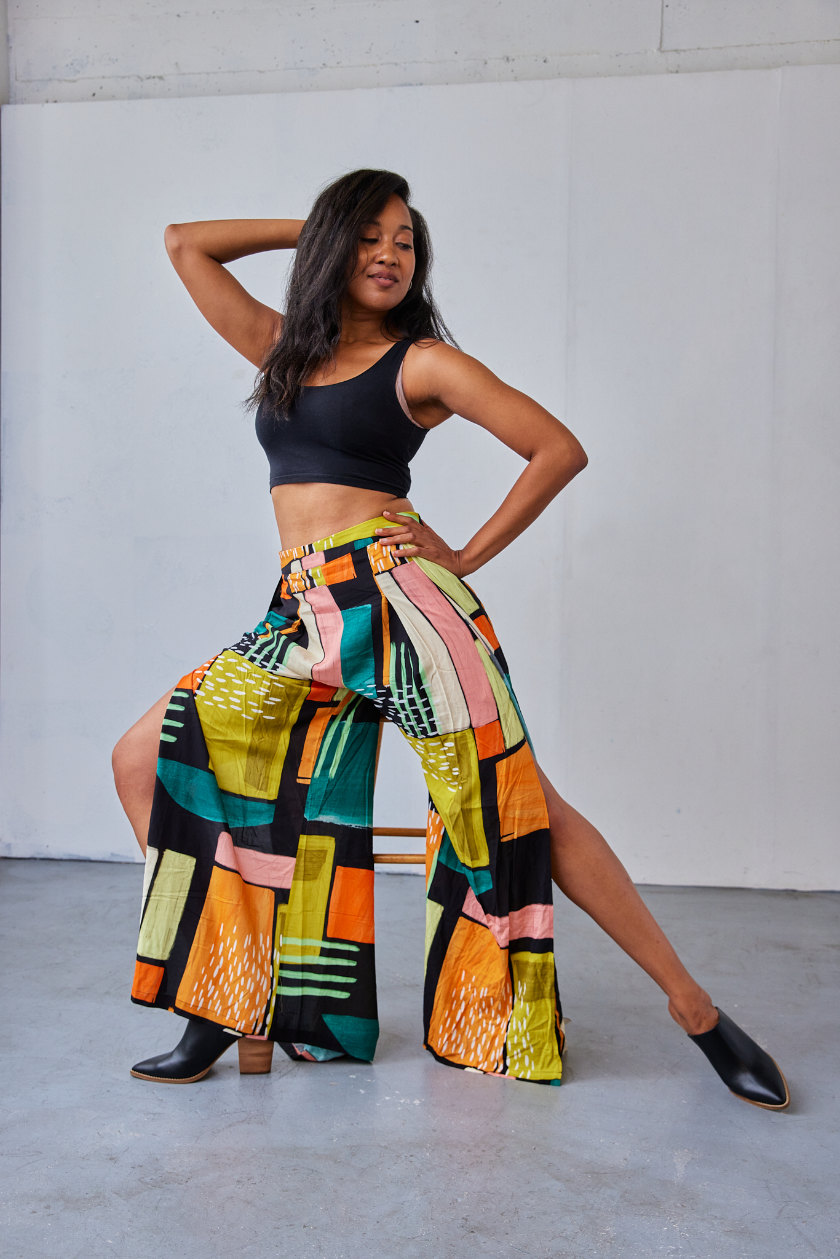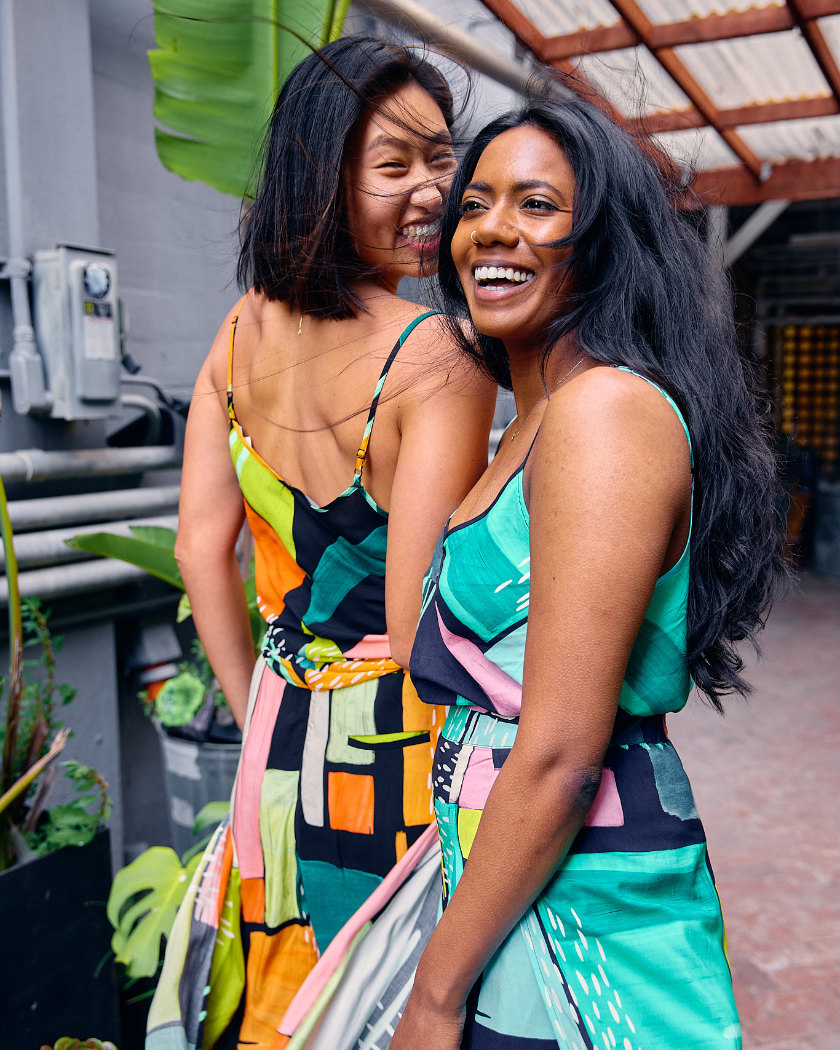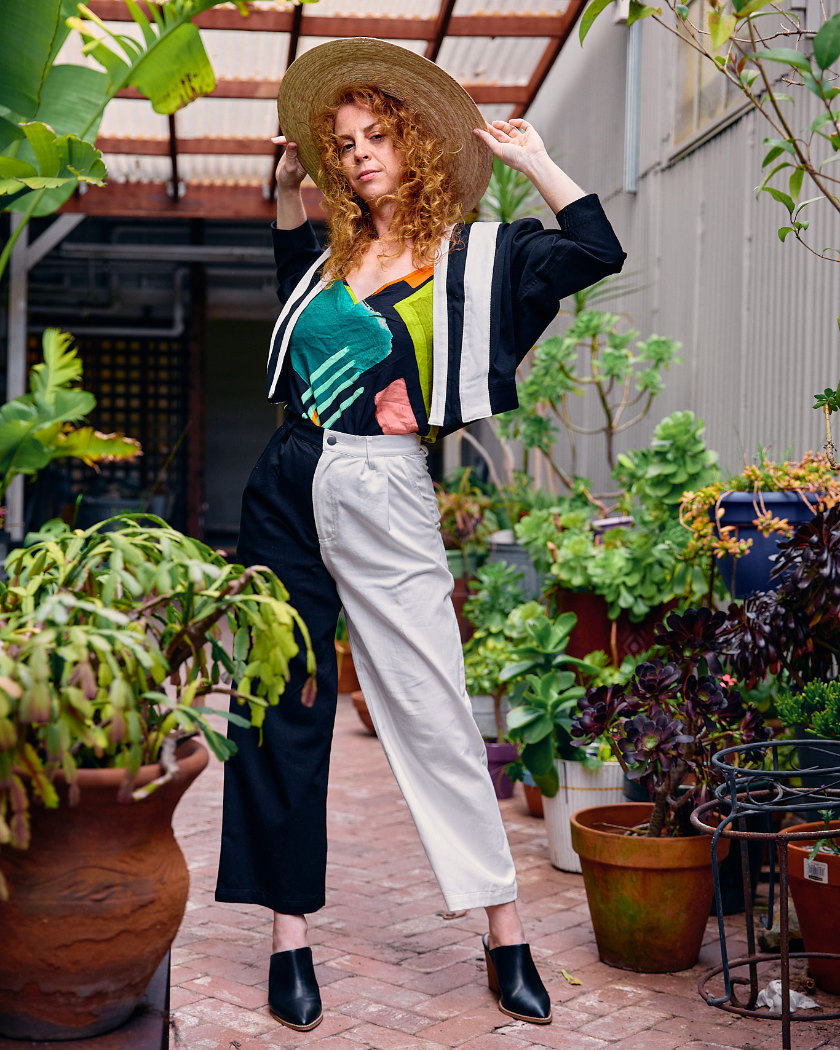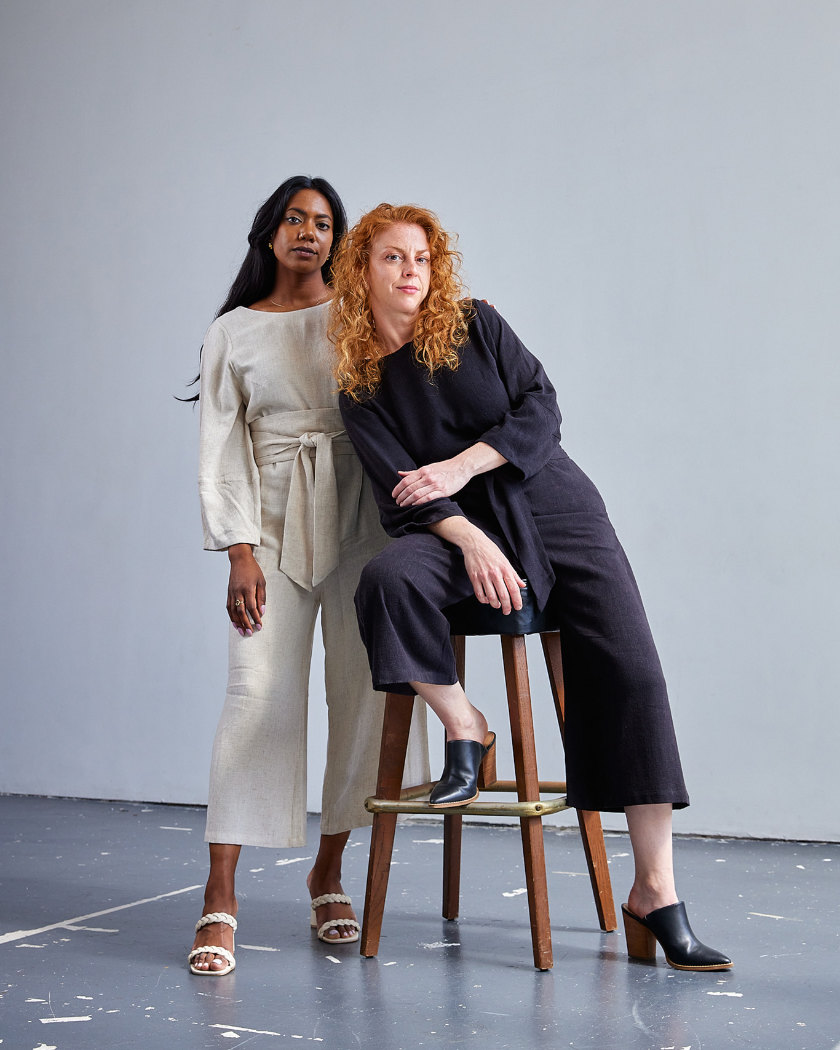
FASHION Hailing from San Francisco and trained in Lyon, Devan Gregori’s journey to her eponymous label is a distinctive one, and shapes her unique approach to sustainable, comfortable and inclusive fashion. Jack Yan interviews her




Above: From Devan Gregori’s Paint collection for spring–summer 2023
Devan Gregori creates comfortable, well designed and sustainable fashion from her base in Oakland, California, creating an answer to questions that might not normally come to mind—but when you realize what she’s done, you wonder why they aren’t asked more often.
Why can’t great fashion have pockets? And be a statement piece?
Not only has she answered them and found plenty of fans across the US and around the world, she has done so responsibly with her manufacturing, and championed inclusiveness with a wide size range. Her sustainability approach goes beyond just using the right fabric: she orders just enough, the scraps are used for scrunchies and other accessories, and the packaging is recyclable and biodegradable. Even the postcards and business cards are made from recycled cotton T-shirts.
‘The Devan Gregori woman is independent and curious. She is adventurous and discerning. She cares about what she puts on her body because feeling at ease in her clothes inspires confidence in whatever she takes on that day. But what I love most about the Devan Gregori woman is that she transcends age and generation. She is a grandmother, she is a mother and she is a daughter, all of whom want beautifully crafted pieces to incorporate into their existing wardrobe, all of whom want to support small independent business with their purchasing power,’ describes Gregori.
Her deep knowledge of her customer base has come from a globe-trotting journey that has been fuelled by her own audacity and seizing every opportunity along the way—and recognizing that if you want to aim high without deep pockets and financiers dictating your every move, you build up your skills and hone your thinking better than the next label.
Gregori’s childhood was spent in San Francisco for many years, initially in Noe Valley, before moving to the Richmond district when she was going into the third grade. After that, the family headed to San Leandro—the Bay Area is very much her home base.
But this wasn’t a childhood where—as so many interviewees say—she was playing around with clothing and sewing machines. In fact, the idea that she could be a fashion designer did not click till her second year of design school at the École de Condé in Lyon, France. ‘The first year of school was a preparatory year, which means we were required to take a class in each design programme they offered (interior design, product design, graphic design, fashion design), along with other courses to complete the European bachelor’s programme,’ she explains.
‘I just fell in love with manipulating textile. I loved making something and seeing it come to life on a mannequin. It felt so gratifying to make something with my hands, not on a computer. And not only that, I could wear it. It wasn’t just something pretty to look at.’
She asked her fashion design professor what the job market was like for people with degrees in the subject. She replied, ‘Devan, people will not stop wearing clothes.’
The same professor opened the first day of classes in her second year, warning the students that only one or two would wind up being designers, though there were other opportunities in the trade. ‘I told myself that day that I would be that one out of these 30 people that would become a fashion designer.’
Prior to that, however, Gregori had studied much closer to home, at UC Berkeley, doing a BA. In her high school freshman year, she chose French as a foreign language to be different to her peers, all of whom took Spanish, the most common language spoken in California. There was another motive: her father is a Francophone ‘so I knew he could help me with my homework.’
She decided to continue with French when she began university. ‘French was always my favourite subject, and I excelled in it. So I decided to major in it! And I’m so glad I did, because I had no idea how that decision would shape my life.’
After graduating, she moved to Lyon, accepted into a French government programme to be an elementary school auxiliary English teacher for a year. ‘It turns out that career path wasn’t for me, and I was at a fork in the road. I had never really considered what I wanted my career path to look like, and teaching didn’t seem to be one I wanted. So what did I want to do?
‘At the same time I met someone and fell in love, and I didn’t want to leave Lyon. At the time, his sister (who was three years older than us) decided that she wanted to go back to school for architecture. It wasn’t a master’s programme. She was going for another bachelor’s degree. And I had this “aha” moment: I could go back to school. I could study something totally different and change my career trajectory … So I applied to design school in Lyon!’
continued below

A determined designer: Devan Gregori
It was during Gregori’s second year that she met designer Yoshi Kondo at the Parisian trade show Première Vision. Having convinced him to take on his first intern, Gregori says, ‘I felt like this sponge that was so saturated, it needed to be squeezed out somewhere so I could continue soaking it all up.’
She explains: ‘I would observe everything Yoshi did, ask him questions, took notes and volunteered to do anything they needed me to. I cut fabric, was the fit model for new styles, created motifs and patterns, worked trade shows, even was the model for one of their collections.’
Through the internship, Gregori learned something very important for any designer. ‘I think above everything, this experience taught me how to think like a designer and a business person, not only like an artist. There is a business element that needs to be incorporated at some point into the creative process. It's a very challenging thing to do, but ultimately, it's this pragmatism that helps you succeed.
Her final year of design school took her back across the Atlantic. Faking an illness and getting a doctor’s note for a week’s rest, she accompanied Kondo to New York to assist him at the Coterie trade show.
Armed with résumés, she contacted smaller brands who were showing there. Mexican label Trista was among them. When heading back to Lyon, she ran into the designer and his partner at the airport. After saying they would keep in touch, Gregori was offered a job to go to Ciudad de México after she had finished school.
‘Experiencing Mexico City in the way that I was able to was one of the most enriching periods of my life. I was surrounded by texture, colour and music. The organized chaos of the city was punctuated with moments of thoughtful, clever design and peaceful reprieves. I was exposed to some of the most exquisite handmade fashion pieces I’ve ever seen. I went to Mexico Fashion Week.’
Returning Stateside, Gregori worked as a project manager in web design but had to build up a nest egg. But she kept her hand in design, with drag queens in San Francisco among her clientèle.
‘Drag taught me to have fun with design. Oh my god, did we have fun! I was free to play with fabrics and elements of fashion that are so not me. Pink stretch taffeta, rhinestones, feathers, big buttons and thigh-high boots, Latex …’
There is a direct relationship to how we all treat fashion, she says. ‘Drag is an exaggerated version of what we do every day. We put on make-up, do our hair just right, perhaps put on shapewear, and ultimately the outfit of choice for the day. It’s how we want to present ourselves in the world. For some, it’s an extravagant affair, and for others it’s much less. But ultimately we all have some kind of version of this ritual.
‘So I developed this new appreciation for the ritual of dressing, and a deeper understanding of what and why I choose to wear what I do. And that thinking is crucial when you’re designing.’
Eventually, Gregori started her label, recognizing that the only way to do something was to go full steam ahead. ‘If I kept waiting around for the perfect moment, that moment would probably pass me by. So I jumped in with both feet. I felt that I had enough knowledge of the industry and connections to help me get started to just go for it.’
That coincided with the COVID-19 pandemic, but some designers who launch during tricky economic times adapt quickly and keep lean operations even as the economy improves. Gregori’s eponymous label appears to have followed this path.
‘I think it was a great levelling moment for myself. I had quit my full-time job to devote myself to building and launching my first collection. I had even moved back in with my parents to save money and finance the label. When shelter-in-place really hit and we all understood the gravity of the situation and the deep unsettling uncertainty of the future, I realized quickly that this was a long game I was playing,’ she says.
‘So I adjusted my approach, which I think allowed me to continue on. I entered the workforce again, got a full-time job and an apartment, and I hustled. I pared down my collection of 25 styles to 12 and I focused on a financial and sustainable business model that would allow me to work my full-time job and also do open air markets, fabric shows, pop-up events, and all the other hats one needs to wear as an entrepreneur. I saved up … so I started and maintained my line without any outside investment. And that still holds true today. I don’t know if I would have made the same initial choices had history been written differently.’
She is also well equipped to being a label owner during a tricky economic cycle, and her web experience seems made for the times. ‘In the past decade, I’ve learned so much about photo shoots, art direction, apparel production, web design, web merchandising, digital advertising, inventory management, sales and marketing, creating systems, and general problem-solving. If there’s something I don’t know how to do, I’m pretty good at figuring it out and being scrappy.’
Her collections reflect her international experience, and embrace a love of colour, proportion, and practicality. ‘I draw inspiration from family history, from pop culture, from vintage patterns, from museum exhibits and from old sketches from design school. For example, I’m designing a jumpsuit right now that is inspired by a jumpsuit that my great-grandmother made back when she worked at the Marilyn Dress Company in the Bay Area. She took silk scraps and created her own striped fabric that she then made a beautiful jumpsuit and matching hat out of. My grandmother passed it on to me, and now I’m using this family heirloom as inspiration for my next design. A way to honour my past.’
She has also managed to find suppliers and manufacturers that meet her demands for sustainability and responsibility. A mill in Lyon produces all her printed fabrics, although she found them at a textile show in Los Angeles. ‘I look forward one day going back to Lyon and actually visiting the mill,’ she says.
Manufacturing, meanwhile, is done in Dalian, China. Gregori dispels any stereotypes about Chinese manufacture. ‘When I was ready to launch my line, I contacted Yoshi Kondo. He invited me to join him on a trip to China to review and edit samples, which I gratefully accepted. The manufacturer we went to meet was actually someone I had met years earlier, while interning for Yoshi. He had since left his previous job and started his own small manufacturing studio along with his partner.
‘While I was there, I was given permission to ask literally any and all questions that came to mind. I toured embroidery and screen printing shops, learned about small- versus large-scale manufacturing, the types of certifications given to ensure ethical practices, fabric sourcing, minimums and scaling, how much workers are paid and what working conditions are like—you name it. And I was given honest answers to all my questions.
‘We worked alongside the team, ate meals with everyone, and I had the rare opportunity to observe how everyone worked together. I loved it—it felt familial.’
That experience sealed the deal, knowing that she had found an ethical small business whose work she admires and appreciates, and is of a high quality. She adds, ‘There are many products that are made in the US or other countries that are unethically made just as there are many products made ethically in China.’
In the last three years, Gregori has made for herself a strong market positioning, and understands who her customer is. Devan Gregori, the brand, is down to earth: it’s authentic and seeks others who believe in the same. She would rather have a customer who loves her work and, if she chooses to share it with a small, engaged audience, then it beats an “influencer” who is paid thousands to promote something on social media. ‘Rather, I'm all about diversity—body shape, complexion, gender identity, whatever it is—if you feel like my brand fits your lifestyle for a particular reason, then I want to know! And that goes for literally anyone, not just influencers.’
continued below


Designs from Devan Gregori’s core collection
She also eschews the “rules” that many believe fashion designers abide by, something she learned through her earlier experiences. ‘I’ve given myself permission to dismiss all the “shoulds” that come along with being an entrepreneur. I should push new styles every season. I should have a proper studio. I should hire people. I should target a younger audience. I should not open a brick and mortar. I should spend a ton of money on advertising and influencer marketing. The list goes on and on.
‘But after working with designers internationally and understanding how they approach design and their business, they weren’t comparing their structure or model after all these other companies or brands. They were doing what worked for them and for their audience. The road isn’t always a straight path, and those curves, twists, turns, alternate routes … they’re all incredibly important because it’s what ultimately differentiates you from everyone else.’
Her future plans are exciting and continue her very rich journey to date. ‘I want to start doing artist collaborations on limited drops, which I’m hoping to start next year. One of my pillars is community, and collaborating with local artists on special projects is a big goal of mine.
Another pillar is inclusiveness. ‘I also want to add plus sizing to my styles. I recently overhauled my sizing chart to be more inclusive. When I started my line, I only offered S, M, L because that’s all I could afford to do across styles. It also was a time for testing, and I didn’t want to invest in grading all my patterns if I was going to sunset some of them. Last year, I increased my size range by offering XS all the way through to XL and increasing the difference between the sizes. My next goal is to add three plus sizes to my line, beginning with my best sellers and then gradually across the whole collection.’
Finally, ‘I’m also committed to introducing a few men’s styles in the future after many requests!’
It’s looking to be a positive, enriching adventure for this energetic Bay Area brand. •

Above: Devan Gregori opened her brick-and-mortar boutique at Rockridge, at 5540 College Avenue, Oakland, Calif. earlier this year.
Jack Yan is founder and publisher of Lucire.
Related articles hand-picked by our editors

Truly timeless
Senza Tempo creates fashion that is timeless and not caught up in gimmicks or trends. Jack Yan talks to its founder and creative director, Kristen Fanarakis, and discovers a unique and considered approach to fashion design
From issue 47 of Lucire

All the love in the world
Lauren DeCarli of Paneros Clothing has ensured that her brand stands up to scrutiny when it comes to its claims of sustainability. Jack Yan looks at the Los Angeles-based eco-fashion label
First published in Lucire issue 44 and in the November 2021 issue of Lucire KSA

Out of the spotlight
Loin des feux de la rampe
There is nothing that Los Angeles-based designer Peter Cohen wants more than knowing his clients shine, feeling fabulous and confident wearing his work
Il n’y a rien que le designer Peter Cohen, basé à Los Angeles, désire plus que de savoir que ses clients brillent, se sentent fabuleux et confiants en portant son travail
First published in the September 2022 issue of Lucire KSA
Dans le numéro du septembre 2022 de Lucire KSA